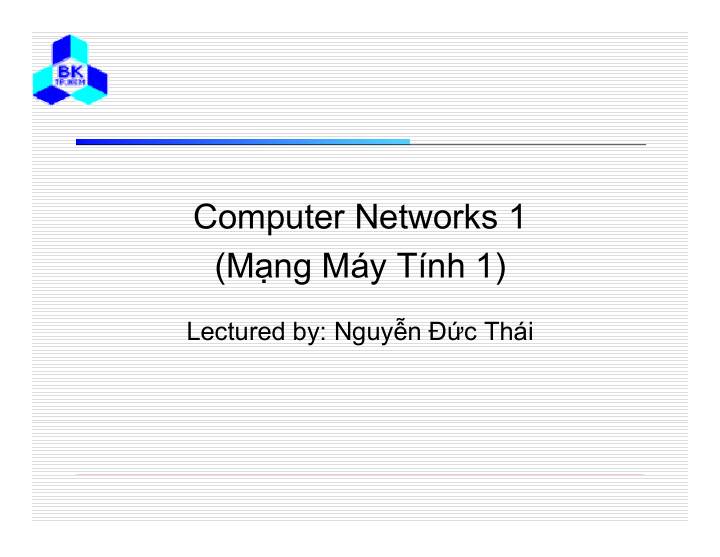



Computer Networks 1 (M ạ ng Máy Tính 1) Lectured by: Nguy ễ n Đứ c Thái
Lecture 2: Communication Media Reference : Chapter 2 - “ Computer Networks ”, Andrew S. Tanenbaum, 4th Edition, Prentice Hall, 2003.
Content � Theoretical basis for data communication � Guided transmission media � Wireless transmission � Digital subscriber lines � Internet over TV cables 3
The Theoretical Basis for Data Communication Fourier Analysis • Bandwidth • Bandwidth-Limited Signals • Maximum Data Rate of a Channel • 4
Fourier Series 5
Bandwidth Signals lose power during transmission � Different transmission facilities diminish different � Fourier components with different amounts -> distortion of signals Usually, high frequency components will be � diminished Bandwidth : range of frequencies can be � transmitted without being strongly attenuated 6
Bandwidth-Limited Signals (1) A binary signal and its root-mean-square Fourier amplitudes. (b) – (c) Successive approximations to the original signal. 7
Bandwidth-Limited Signals (2) (d) – (e) Successive approximations to the original signal. 8
Bandwidth-Limited Signals (3) Relation between data rate and harmonics for a voice telephone line 9
Guided Transmission Data Twisted Pair • Coaxial Cable • Fiber Optics • 10
Twisted Pair (a) Category 3 UTP. (b) Category 5 UTP. 11
Coaxial Cable A coaxial cable. 12
Fiber Optics (a) Three examples of a light ray from inside a silica fiber impinging on the air/silica boundary at different angles. (b) Light trapped by total internal reflection. 13
Transmission of Light through Fiber Attenuation of light through fiber in the infrared region. 14
Fiber Cables (a) Side view of a single fiber. (b) End view of a sheath with three fibers. 15
Fiber Optic Networks A fiber optic ring with active repeaters. 16
Fiber Optic Networks (2) A passive star connection in a fiber optics network. 17
Wireless Transmission The Electromagnetic Spectrum • Radio Transmission • Microwave Transmission • Infrared and Millimeter Waves • Lightwave Transmission • 18
The Electromagnetic Spectrum The electromagnetic spectrum and its uses for communication. 19
Radio Transmission (a) In the VLF, LF, and MF bands, radio waves follow the curvature of the earth. (b) In the HF band, they bounce off the ionosphere. 20
Lightwave Transmission A bidirectional system with two lasers is pictured here. 21
Communication Satellites Geostationary Satellites • Medium-Earth Orbit Satellites • Low-Earth Orbit Satellites • Satellites versus Fiber • 22
Communication Satellites Communication satellites and some of their properties, including altitude above the earth, round-trip delay time and number of satellites needed for global coverage. 23
Communication Satellites (2) The principal satellite bands. 24
Modems, ADSL, and Wireless 25
Modems (c) Frequency modulation (a) A binary signal (d) Phase modulation (b) Amplitude modulation 26
Digital Subscriber Lines - ADSL Bandwidth versus distanced over category 3 UTP for DSL. 27
Digital Subscriber Lines – ADSL (2) Operation of ADSL using discrete multitone modulation. 28
Digital Subscriber Lines (3) A typical ADSL equipment configuration. 29
Internet over Cable Cable television 30
Internet over Cable (2) The fixed telephone system. 31
Spectrum Allocation Frequency allocation in a typical cable TV system used for Internet access 32
Recommend
More recommend